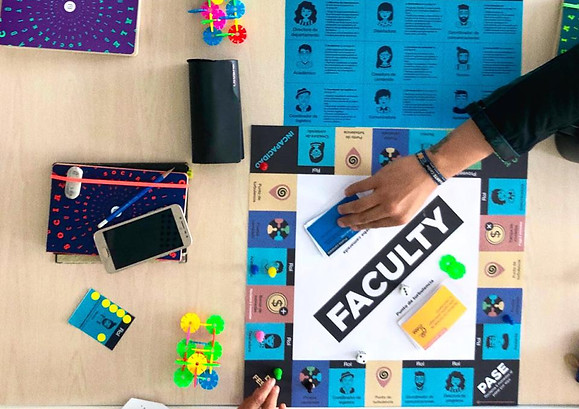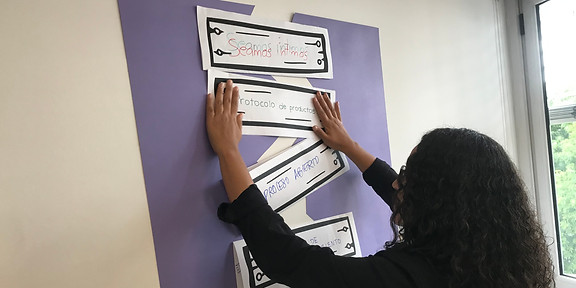
Design of the service delivered by the communications area of the Faculty of Social Sciences at Los Andes University

Service Design + UX Research
Overview
Description
The brief of this project was to design a communication strategy for the Social Sciences Faculty at Los Andes University focused on the user experience of the website. As the project progressed, multiple problems between the Communications area and different stakeholders slip into focus, making it necessary to redesign the service to build a strong communication strategy.
The result of the project was: the definition of protocols and measures that supported the team in creating efficient workflows and building environments and gatherings that enable effective communication, usability tests that provided user experience guidelines to redesign the new website and communicate through social networks, and a board game to play with different stakeholders to increase empathy and facilitate the communication between them.
Role
Freelance Service Designer and UX Research Consultant
Project parameters
4 months length - Individual project
Client
Faculty of Social Sciences - Los Andes University - Bogotá, Colombia

Phase 1: Understanding the teamwork
The starting point of this project was to understand the workflow of the communications area: how they organize their work and how they collaborate. This understanding was gained through in-depth interviews with each member of the team.
The research revealed that the workflow of the team has three dimensions:
- Dynamics to work together (team building)
- Processes to get their work done
- Processes to communicate and work with other stakeholders.
Each dimension has values and pain points that define the experience of the team working for the Faculty. That information was presented during a workshop and was the trigger for an ideation session with the team. Those ideas became solutions for the main problems the team was facing and I build a map that synthesizes the strategy in each dimension.









Phase 2: Understanding the needs of the stakeholders

To understand the needs and expectations of the stakeholders from the communications area, I conducted in-depth interviews with program directors, professors, administrative personnel, and academic coordinators.

Following the analysis of the information, I conducted a second workshop with most of the faculty collaborators, presenting what they expressed about the area and giving the area a possibility to explain the team structure and each role.

To present the identified problems, I used the metaphor of fissures or fractures that form a gap between them and the area. The challenge for them was to work together in groups to find a way to repair the fissure.

At the end of the workshop, and for the first time, the communications area and the stakeholders worked together on four solutions to repair the fissures. This session allowed them to be more empathetic and improve relationships.
Phase 3: Usability tests
The previous phases of the project provided the Faculty a strategy to communicate and work effectively with the internal stakeholders. The third phase supplied a great understanding of how compelling was the communication between the Faculty and the external stakeholders (applicants, students, graduates, and professors) through the website and social networks.
To acquire that knowledge, I conducted usability tests of the website and the social networks, capturing needs in user experience, interface design, content, tone, and language. These tests were performed in groups with the applicants and individually with the rest of the stakeholders mentioned above.
The result of this research was:
-
A detailed report that evaluated the website in terms of content and usability.
-
User experience guidelines to design a new website that solves most of the problems identified.
-
A social network strategy for each stakeholder: undergraduates and graduates applicants, students, and professors.
%207.png)
Phase 4: Creating empathy
To implement the communication strategy, it was necessary to keep building empathy. That process takes time, collaborative work, and the willingness of stakeholders to cooperate and understand each other. I found it essential to design a tool that allows the team to continue that process. The result was a table game named Faculty.
The objective of the game is to solve cooperatively missions that earn you coins to win the game. The missions are statements of projects that the faculty has, the players must wear the shoes of one of the roles the faculty has and mention what would that role do to solve the project. The winner is the first person that earns 50 coins.
The game makes it fun to understand the duties of each role. It also empowers co-workers from different areas to interact with each other, break the ice and understand the hurries of each person.


It was also fun for the participants to play with the coins and build shapes while waiting for their turn.
Phase 5: Roadmap
The strategy was divided into small tasks. Each was prioritized, assigned to a member of the communications team, and set in a roadmap. This tool will allow the team to know exactly what to do and the times.
After my work as a consultant and despite the 2020 contingency, the team successfully achieved their goals:
-
They launched the new website at the beginning of 2021, with great UX and a strong content strategy that successfully communicates the information that applicants, students, graduates, and professors need. https://cienciassociales.uniandes.edu.co/
-
They opened their Instagram account and started communicating effectively through social networks with the target audience: Facebook, Instagram, Twitter.
-
They strengthened their relationship with the members of the faculty. They now work as a team and the website made it easy to improve the reputation of the area.

Biggest Learnings
-
This project enabled me to exploit my skills. The fact that I could use research and creativity to deliver effective tools and improve the workflow of the team was rewarding.
-
It was one of the first times in which I could see, as a consultant, a client implements a strategy in a short term. I am sure that this was because I worked close to the head of the area. This person opened the way for me to co-create with the stakeholders and propose big ideas.
-
A great team with a good leader is capable of facing big challenges. Timing and organization is the key to accomplish a big goal.